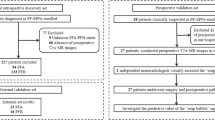Abstract
Purpose
Imaging descriptions of posterior fossa ependymoma in children have focused on magnetic resonance imaging (MRI) signal and local anatomic relationships with imaging location only recently used to classify these neoplasms. We developed a quantitative method for analyzing the location of ependymoma in the posterior fossa, tested its effectiveness in distinguishing groups of tumors, and examined potential associations of distinct tumor groups with treatment and prognostic factors.
Methods
Pre-operative MRI examinations of the brain for 38 children with histopathologically proven posterior fossa ependymoma were analyzed. Tumor margin contours and anatomic landmarks were manually marked and used to calculate the centroid of each tumor. Landmarks were used to calculate a transformation to align, scale, and rotate each patient’s image coordinates to a common coordinate space. Hierarchical cluster analysis of the location and morphological variables was performed to detect multivariate patterns in tumor characteristics. The ependymomas were also characterized as “central” or “lateral” based on published radiological criteria. Therapeutic details and demographic, recurrence, and survival information were obtained from medical records and analyzed with the tumor location and morphology to identify prognostic tumor characteristics.
Results
Cluster analysis yielded two distinct tumor groups based on centroid location The cluster groups were associated with differences in PFS (p = .044), “central” vs. “lateral” radiological designation (p = .035), and marginally associated with multiple operative interventions (p = .064).
Conclusions
Posterior fossa ependymoma can be objectively classified based on quantitative analysis of tumor location, and these classifications are associated with prognostic and treatment factors.



Similar content being viewed by others
References
Ostrom QT, de Blank PM, Kruchko C, Petersen CM, Liao P, Finlay JL, Stearns DS, Wolff JE, Wolinsky Y, Letterio JJ, Barnholtz-Sloan JS (2015) Alex’s Lemonade Stand Foundation infant and childhood primary brain and central nervous system tumors diagnosed in the United States in 2007-2011. Neuro-Oncology 16(Suppl 10):x1–x36. doi:10.1093/neuonc/nou327
Vaidya K, Smee R, Williams JR (2012) Prognostic factors and treatment options for paediatric ependymomas. J Clin Neurosci 19(9):1228–1235
Kasliwal MK, Chandra PS, Sharma BS (2007) Images in neuro oncology: primary extraaxial cerebellopontine angle ependymoma. J Neuro-Oncol 83(1):31–32. doi:10.1007/s11060-007-9330-6
Sanford RA, Merchant TE, Zwienenberg-Lee M, Kun LE, Boop FA (2009) Advances in surgical techniques for resection of childhood cerebellopontine angle ependymomas are key to survival. Childs Nerv Syst 25(10):1229–1240. doi:10.1007/s00381-009-0886-7
Ikezaki K, Matsushima T, Inoue T, Yokoyama N, Kaneko Y, Fukui M (1993) Correlation of microanatomical localization with postoperative survival in posterior fossa ependymomas. Neurosurgery 32(1):38–44
U-King-Im JM, Taylor MD, Raybaud C (2010) Posterior fossa ependymomas: new radiological classification with surgical correlation. Childs Nerv Syst 26(12):1765–1772
Tamburrini G, D’Ercole M, Pettorini B, Caldarelli M, Massimi L, Di Rocco C (2009) Survival following treatment for intracranial ependymoma: a review. Childs Nerv Syst 25(10):1303–1312
Schindelin J, Arganda-Carreras I, Frise E, Kaynig V, Longair M, Pietzsch T, Preibisch S, Rueden C, Saalfeld S, Schmid B (2012) Fiji: an open-source platform for biological-image analysis. Nat Methods 9(7):676–682
Rasband W (1997) 1997–2012. Image J. US National Institutes of Health, Bethesda, MD, USA, Available at: htt p. imagej nih gov/ij 2012
Schmid B, Schindelin J, Cardona A, Longair M, Heisenberg M (2010) A high-level 3D visualization API for java and ImageJ. BMC Bioinformatics 11(1):274
Ollion J, Cochennec J, Loll F, Escudé C, Boudier T (2013) TANGO: a generic tool for high-throughput 3D image analysis for studying nuclear organization. Bioinformatics 29(14):1840–1841
Team RC (2014) R: a language and environment for statistical computing. R Foundation for Statistical Computing, Vienna, Austria, 2012. ISBN 3–900051–07-0,
Murtagh F (1985) Multidimensional clustering algorithms. Compstat Lectures, Vienna: Physika Verlag 1985:1
van Veelen-Vincent ML, Pierre-Kahn A, Kalifa C, Sainte-Rose C, Zerah M, Thorne J, Renier D (2002) Ependymoma in childhood: prognostic factors, extent of surgery, and adjuvant therapy. J Neurosurg 97(4):827–835. doi:10.3171/jns.2002.97.4.0827
Figarella-Branger D, Civatte M, Bouvier-Labit C, Gouvernet J, Gambarelli D, Gentet JC, Lena G, Choux M, Pellissier JF (2000) Prognostic factors in intracranial ependymomas in children. J Neurosurg 93(4):605–613. doi:10.3171/jns.2000.93.4.0605
Witt H, Mack SC, Ryzhova M, Bender S, Sill M, Isserlin R, Benner A, Hielscher T, Milde T, Remke M, Jones DT, Northcott PA, Garzia L, Bertrand KC, Wittmann A, Yao Y, Roberts SS, Massimi L, Van Meter T, Weiss WA, Gupta N, Grajkowska W, Lach B, Cho YJ, von Deimling A, Kulozik AE, Witt O, Bader GD, Hawkins CE, Tabori U, Guha A, Rutka JT, Lichter P, Korshunov A, Taylor MD, Pfister SM (2011) Delineation of two clinically and molecularly distinct subgroups of posterior fossa ependymoma. Cancer Cell 20(2):143–157. doi:10.1016/j.ccr.2011.07.007
Nagib MG, O’Fallon MT (1996) Posterior fossa lateral ependymoma in childhood. Pediatr Neurosurg 24(6):299–305
Merchant TE, Li C, Xiong X, Kun LE, Boop FA, Sanford RA (2009) Conformal radiotherapy after surgery for paediatric ependymoma: a prospective study. Lancet Oncol 10(3):258–266
Yuh E, Barkovich A, Gupta N (2009) Imaging of ependymomas: MRI and CT. Childs Nerv Syst 25(10):1203–1213
Sala F, Talacchi A, Mazza C, Prisco R, Ghimenton C, Bricolo A (1998) Prognostic factors in childhood intracranial ependymomas: the role of age and tumor location. Pediatr Neurosurg 28(3):135–142
Author information
Authors and Affiliations
Corresponding author
Ethics declarations
Conflict of interest
We declare that we have no conflict of interest.
Additional information
This work was supported in part by the National Cancer Institute through a Cancer Center Support (CORE) grant (CA21765) and by the American Lebanese Syrian Associated Charities (ALSAC).
Electronic Supplementary Material
Supplementary Table 1
(DOCX 18 kb)
Rights and permissions
About this article
Cite this article
Sabin, N.D., Merchant, T.E., Li, X. et al. Quantitative imaging analysis of posterior fossa ependymoma location in children. Childs Nerv Syst 32, 1441–1447 (2016). https://doi.org/10.1007/s00381-016-3092-4
Received:
Accepted:
Published:
Issue Date:
DOI: https://doi.org/10.1007/s00381-016-3092-4




